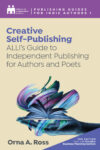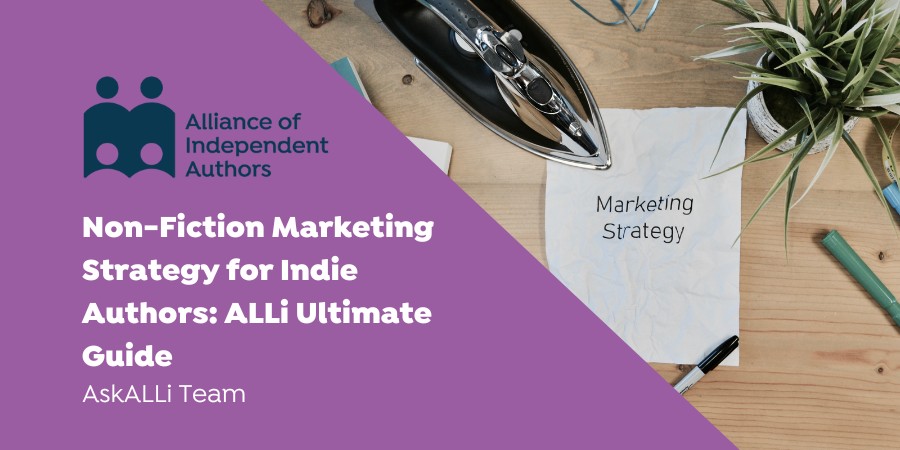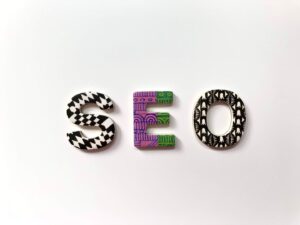Here at ALLi, we know that publishing a non-fiction book is a remarkable achievement. But ensuring it reaches the right audience and leaves a lasting impact requires further work that begins with a well-crafted author marketing plan.

Today, we're taking a closer look at how to design your non-fiction marketing strategy, including sharing our six steps; from understanding your readers, to establishing your profile in the sector, and automating your marketing activity.
For further marketing tips and tricks, pick up the ALLi guide Creative Self-Publishing. This book is available for purchase in multiple formats in our bookstore. Members enjoy free access to the eBook.
What’s the difference between marketing and promotion?
It's easy to confuse book marketing and promotion. Although connected, they are not the same thing. Each requires its own plan and considerations.
- Marketing = ongoing activity that ensures the right readers know you exist as a writer, that your books exist as a product, and that it’s clear what sort of books you offer. Marketing activity builds your profile and your relationship with your audience.
- Promotion = activity that is usually time-limited and focused on a specific event; such as a launch, book tour, or giveaway. Promotional activity aims to lead directly to a sale.
Marketing activity includes: your author website, book covers, book descriptions, review requests, email lists, reader funnels, ongoing social media activity, and any physical assets like bookmarks and postcards.
The ultimate goal of marketing is to ensure what the business calls “findability”— that the right readers can find you and your books at the right time, and that what you offer to them is immediately clear.
Find out more about marketing and promotion
For more detail about the differences between your marketing and promotion plans, take a look at our Seven Processes of Publishing: Book Marketing post. And if you're looking for further advice on book promotion, including links to popular promo opportunities for indie authors, take a look at our Seven Process of Publishing: Book Promotion post.

Photo by Campaign Creators on Unsplash
Non-fiction marketing: a long-term commitment
Non-fiction stands apart from fiction by offering knowledge, insights, information, and solutions to a reader. While a reader might take a chance on a fiction book on a whim, the chances are they will only pick up non-fiction when it offers what they need or want right now, and comes from a credible source.
Therefore, instead of bombarding the audience with sales pitches, non-fiction marketing is based on building a credible brand, offering evidence of the author’s knowledge in the subject or subjects they cover and reaching readers looking for or needing what they offer.
So, marketing your non-fiction work is not a short-term strategy. Throughout your writing career, it will remain a constant. Non-fiction authors are looking to establish a trusted profile and then build a long-term relationship with their readers to keep them coming back for more and recommending to others.
These six steps will help you build a plan to find and engage with your audience and increase the reach of your non-fiction book.

Photo by AbsolutVision on Unsplash
Six steps to building your non-fiction marketing strategy
1. Understand your readers
If you read just one of these tips – make sure it’s this one!
A non-fiction marketing strategy can only be successful with a thorough understanding of the readers you want to reach at the outset. The resulting knowledge will underpin every following action you take.
Understanding the target audience allows you, as your book’s marketer, to tailor activity and content to your readers' specific needs. At its most effective, this personalized approach can build a sense of community around your book and subject.
While it may seem inclusive to target as many people as possible, going wide does not always equal more sales. When you design your marketing hoping to attract “everyone”, in practise your genuine readers may be put off. They won’t know what kind of book you offer, or recognise it is for them, so they will often take a pass and pick up something else.
If this is you, it’s time to switch your mind set. Rather than trying to reach “everyone” think of your goal as aiming your book obviously and exclusively at your “niche” (or for some topics an even more targeted “micro-niche”). Understand everything about the most likely readers of your book, then plan your marketing activity to attract them. Once you find your niche, you’ve found your potential fanbase, and their long-lasting loyalty becomes the core of your author business.
An added benefit of this approach is that while your target audience enthusiastically raises your profile and shares your work, you will inevitably begin to reach readers beyond them further down the line.
Create reader personas to aid your planning
Building up a bank of personas of the people in your niche will help you think like them and understand how to speak to them effectively. Some questions to ask include:
- Are any demographics relevant – such as age group?
- What are your reader’s inner attributes – their beliefs and goals, their political leanings or fears and worries?
- How might they spend their spare time – where are they, what are they doing, what are they interested in?
- Who do they trust – who or what influences their beliefs and actions?
- How do they like to read – what devices or formats do they use, and where do they buy their books?
The answers to these questions need to be more than guesswork. Take time to consider them from your own experience, then see if you can find evidence that backs up or contradicts your hunches.
Most countries will have demographic information available, for example the ONS (Office of National Statistics) in the UK. If you currently have an email list or a social media following, you could poll your audience to understand them better. You could also join a forum on your topic – what are they discussing, who is there, what trends can you spot? Finally, it can be useful to learn from comparable authors covering your topic. How have they marketed their work, and can you spot who they target?
The audience understanding you build here should then permeate every marketing activity you undertake, from covers and book descriptions, to newsletters and social posts. When the time is right, your in-depth knowledge of your readers will also support your promotional activity – including ad design and targeting strategies.
For more on discovering the right reader, take a look at our Ultimate Guide to Finding the Right Readers for your Book.
2. Leverage the benefits of your book
In fiction, the marketing focus is often on the emotional journey and the enjoyment of the story, and in some instances emphasising how it fulfils an audience genre expectations.
When marketing non-fiction, emphasizing how your book solves a problem or enhances readers' lives can draw in potential readers looking for knowledge or solutions.
By getting to know your books from the reader’s perspective, you can tease out your book’s potential points of difference, uniqueness, and value. This will help you craft effective marketing copy, such as book descriptions, posts, or blogs.
Take some time to think about:
- What problem or problems does your book solve?
- What top three lessons does your book teach or impart?
- How might your book make your readers' lives easier, better, or more enlightened?
- How might a reader use what you share to try something new?
- What is the change or transition your book will take a reader on – how will they be different at the end?
- What unique experience or skill do you bring as an author to the book/topic?
- What other topics does your book crossover with?
Why not consider how you would pitch your book to a potential reader or distributor? Practising summing up your work concisely and with impact, while emphasising the benefits it offers, can focus your mind on your unique selling points. You can find key steps to producing the perfect pitch in ALLi's Ultimate Guide to Pitching for Independent Authors.
3. Establish credibility and authority
Establishing yourself as an authority in your sector can be crucial. Consider sharing your expertise through blog posts, articles, community forums, and speaking engagements focused on your niche. By reaching out into the right communities across these different activities, you will speak directly to people looking for the information you are giving and establish yourself as a trusted voice.
Identify influencers, bloggers, or podcast hosts in your niche and collaborate with them. Guest posting, podcast interviews, or joint webinars can expand your reach to a wider audience. Authentic partnerships often resonate better than forced promotions, and influencers in your sector can become advocates for your books.
Before you work with an influencer, make sure you understand who they are and whether working with them aligns to your own work and values. These questions, from ALLis, Ultimate Guide to Influencer Marketing, are a good place to start – and you can read the full post for much more information about working with influencers to market your work:
- Does the influencer’s audience align well with my books’ values and mission?
- Does this person have genuine authenticity and authority?
- Does their voice align with mine?
- Are their visual communications complementary?
- How do they respond to comments?
- Are there significant differences in tone across different platforms?
Reviews as trusted testimonials
In non-fiction, reviews carry the weight that would be provided by customer testimonials for suppliers. When choosing between your book and another on the subject, readers are looking for reassurance from others that you are the right person to offer the information and advice they need.
Some authors put an ARC (Advance Reader Copy) strategy in place before launch. This means sharing digital or print copies of your book in advance with a select group of people, usually called your ARC team. The team members are granted an early copy of the book before its launch with the understanding that they will consider placing an honest review early on. Some authors are not comfortable with this exchange, but it may be right for you if you have a niche group who you can trust to read and review copies honestly before launch. Honesty is always key here, as sites such as Amazon will actively look for books which appear to have unethically sourced reviews and remove them.
For more in-depth analysis of your non-fiction book, you can identify and share advance copies with key bloggers in your sector to build reviews and comments from experts in the field that they will place on their own channels. This will create a conversation in the right spaces with potential readers about the views, information, or advice you've shared.
There's no magic trick for gaining organic reviews. But reviews on critical sale sites, such as amazon, often come from the readers you have built a strong indirect relationship with beyond your book. All the tips here relating to building your profile and credibility in the sector will help kick-start your review momentum. Readers who feel a personal stake in your work and your profile will be far more likely to share their feedback via reviews, and recommend your book to others.
On a practical level, consider adding a reminder in the back matter of your books to prompt people to leave a review on their favoured site. This works particularly well in your ebooks, where you can link straight to the amazon, or other site, review page. Prompting people with clear calls to action about leaving reviews on your website in giveaways and in newsletters will also remind your readers just how important reviews are to you as an author.
4. Craft a compelling online presence
In today's digital age, your online presence matters immensely. Most authors start by building a professional author website. This will be the hub for all your marketing activities.
On your website, include a captivating author bio emphasising your skills and experience and a clear book synopsis outlining the benefits of your book. Consider also adding a blog section that will give you the chance to offer valuable insights related to your book's theme. Blogs bring the benefit of being easily shared across social media too.
Digital content in all forms is a secret weapon for a non-fiction marketing strategy and will build a collection of items to share on your website, in newsletters, and your social channels. The goal is to use this content to drive people continually back to your book. “Content” can mean a written article or blog, a video, an image, a social post or more. You can create and share engaging content specifically related to your book, such as quotes, behind-the-scenes anecdotes, and related articles drawing out a key point.
Social media platforms can be your virtual megaphones. Choose platforms that resonate with your audience – you can find information online about the age and interests of users on different platforms that can help you select the right channels for you. If you go this route, social media posts should be regular and consistent, ideally multiple times a week or even every day. You can create a content calendar to maintain consistency and help you feel ready to interact with your followers regularly.
Search Engine Optimization (SEO)
Search Engine Optimization (SEO) is an integral part of any modern marketing strategy. At its most basic level, “Optimizing” the information about your book, as well as any related digital content you create, means ensuring you identify relevant keywords and include them multiple times. This improves the likelihood that when someone searches using those words, your content will appear in the results list.
Make sure you include the keywords multiple times. For example, in a blog post it should be in the title, introduction and several times throughout the text. And if you have a site where you can add tags or label images, include keywords there too. This helps search engines identify your content as answering the searchers question.
But don’t try to trick the search engine by adding popular words not related to what you offer. It must relate to what you have described, or search engines will begin to drop it from their results and your audience won’t trust what you offer is what they need.
What does writing for SEO mean in practice?
One key place SEO is important is content and page titles. It can be tempting to produce creative, lengthy titles for our articles or blogs, as we might in print media, but when writing for SEO, the clearer, more concise, and accessible the better. To identify findable keywords and titles, the trick is to imagine the main words or phrases a reader may put into the Google search box if they want to find what you have to offer.
So, let's imagine your non-fiction book is related to the works of William Shakespeare. You've created a blog to reach potential readers on what you view are the most important Shakespeare quotes any reader should know and why. The plan is for people with an interest in the topic to find this blog and then see the link to your book. What do you call the post?
Original title: What's in a name? My favourite lines from the bard
Optimized title: Top ten iconic Shakespeare quotes
The second option has put ‘Shakespeare quotes' front and centre. This is the keyword phrase you will then use throughout your article and in tags. It indicates to a search engine that this is the most important element of the content. Instead of referring to the writer as a ‘bard', the new title includes the more likely search name, ‘Shakespeare'. The title is also shorter and to the point, and reflects a phrase someone may put into a search engine for this topic.
The more creative title originally produced isn't wasted effort. It can now be used as a subheading within the post, to ensure when your readers come to your article, they find the tone and style they expect from you.
Besides considering your titles and keywords, making sure your content is recognised as accessible and high quality by search engines and readers alike. This will also help it be found and shared. At a minimum, consider:
- breaking up text with subheadings to ensure it's easy to follow
- using bulleted lists where useful
- adding relevant images to help bring the content to life
- using alt (alternative) text for images to make them accessible
- linking to other useful, high-quality content on your own site and on others
If you are looking to read up on the full complexities of SEO, you may want to take a look this comprehensive Backlinko post: here. The post is regularly updated and reflects recent Google search methodology.
5. Build your mailing list
Now this is a big one. No indie author marketing plan is complete without that all important mailing list. This is where you collect your committed readers and ensure continued conversations with them for key milestones on your author journey. Your list will start small but will build as your career progresses.
You'll need a quick and easy sign-up system on your website, with a link or QR code you can share everywhere you interact with your readers, and potential readers. Your website provider may include a newsletter functionality, or there are many providers are out there that offer a ‘plug-in' or link you can add to your site quickly and easily. There is a useful comparison tool here, where you can add or remove providers to compare.
A big incentive for readers to subscribe to your regular mailers is to offer what is often called a “reader magnet”. This is a free piece of content related to your books, which can only be accessed by subscribing. It could be in text, audio, or video format. But, whatever you offer must develop on what your audience has already received from you, and align closely with the books or products you want them to buy.
Non-fiction reader magnet ideas:
- a short ebook on a related topic to your main content, or one that expands on a specific theme from your book
- a useful downloadable checklist, cheatsheet or planning template to support readers following steps from your book
- a ‘workbook' taking the key elements from your book and providing worksheets, prompts and activities to follow
- a video tutorial expanding on a specific element of your book
- an audio interview with you as the author, sharing more information on your specialist topic
Once your readers have signed up, they will anticipate regular contact. Plan your emails to a regular schedule; this helps continue to build trust with your audience. The emails should match the look and tone of the social media communications or ads that originally attracted and engaged them, and should be written in a way that replicates and reinforces the writing style of your books.
Your readers should look forward to opening your emails. They should feel valued when they read what you have to say, as if they have access to something special that comes direct from you, the author.
One watch out for mailing lists – remember that you must get permission to store email addresses and to email people your newsletter. You must not add people to the list without this permission given, even friends or acquaintances. ALLi's Authors' Legal Guide to Email Lists shares more information on this topic.
If you are just setting up your mailing list, be sure to read up on all the details with our three part ALLi Ultimate Guide to Email Marketing. Start off with Part One where you'll pick up advice on choosing your mailer provider, topics to cover in your newsletters and key considerations before you set up.

Photo by Myriam Jessier on Unsplash
6. Standardize and automate
Ongoing marketing can be time-consuming, particularly if you are also writing your next best seller or have other responsibilities to consider. Therefore, one goal when you start a new strand of marketing activity is to standardize and automate the processes as much as possible as quickly as possible.
Automating marketing activities involves the use of technology and tools to streamline, schedule, and optimize various aspects of a marketing campaign. Regular marketing processes such as e-newsletter distribution, social media posting, and analytic reporting can be automated using your preferred software.
For example, software such as Mailchimp, and many other providers, can be used to produce and schedule not only your newsletter mailers, but social media posts across your channels, days and weeks in advance. This means you can set aside one point in your calendar to produce and set your posts and then let the software do the work.
If you have built your website on a platform such as WordPress, you can use ‘plug-ins' to automate social media promotion for your blog posts and articles. At the click of a button, the software can produce and schedule a series of posts that will be sent out as soon as your content is live, and at intervals afterwards. This ensure people following your channels have the highest chance of seeing your content in the coming weeks.
There are lots of options on the market, and you'll need to find the right one for your website platform and your budget. Comparison sites have produced lists by platform which can help you decide which one may be right for you.
Don't forget the human touch
It's important to strike a balance between automation and maintaining a human touch of authenticity. So, while you should automate as much of your ongoing marketing activity as possible, make sure you still touch base with your audience yourself. This will include monitoring and responding to comments on your social posts, and replying to reader emails promptly to ensure they remember you are a person behind the book.
Readers enjoy interacting with their favourite authors, so ensuring they can contact you and get a response is important for building an ongoing relationship with your audience and maintaining their interest in your work.
Kick off your non-fiction marketing strategy today
Successfully marketing a non-fiction book is an art that requires careful planning and ongoing commitment. And it’s never too late to start or adapt your approach.
By understanding your audience, building your profile in the sector, creating engaging content to drive readers to your books, and leveraging the power of digital platforms, you can ensure your work gets the attention it deserves.
Every marketing effort is a step toward building your platform and a lasting connection with your readers. So, embrace the journey, and watch your book take off!
 Looking for more?
Looking for more?
If this post has got you thinking about your marketing strategy afresh, don't forget to look back at our backlist of blogs on processes five (marketing) and six (promotion) from the seven processes of publishing.
They include information on a range of topics, from producing impactful calls to action, to developing your author aesthetic. All are brought together in this collection of Marketing and Promotion Blogs on the ALLI website.



 Looking for more?
Looking for more?


Having a clear, user-friendly sign-up system on my website is a must, with easily shareable links and QR codes that I can incorporate into all my reader interactions, both online and in person.